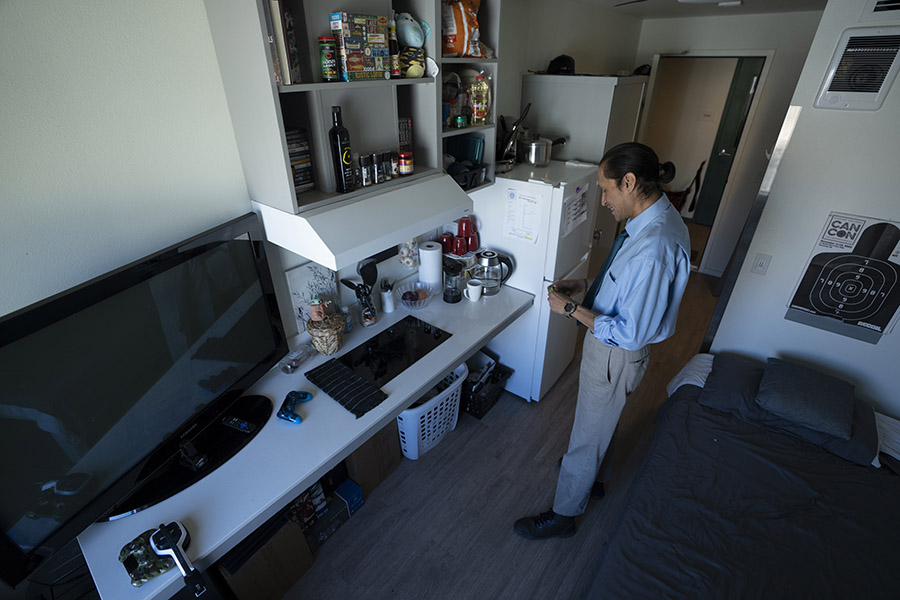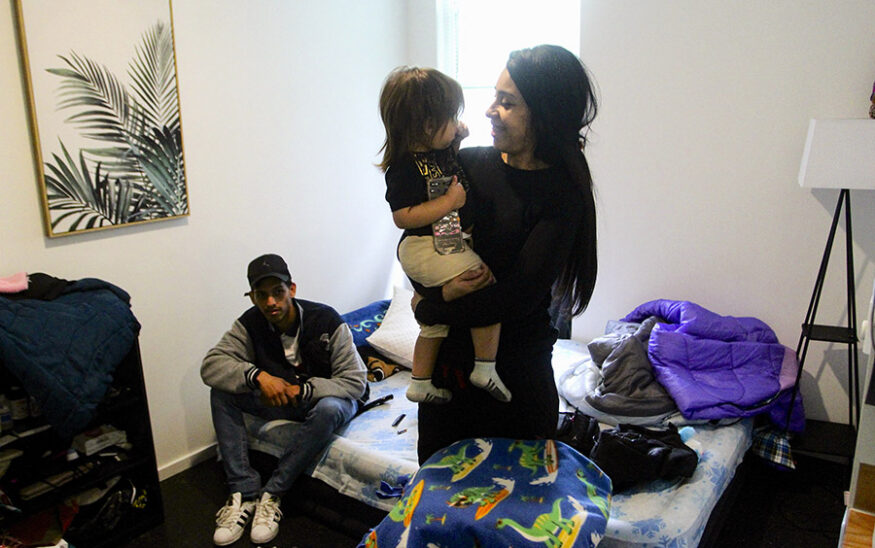New laws may lead to more micro-apartment projects
The Associated Press//March 29, 2024//
By Hallie Golden and Claire Rush
The Associated Press
SEATTLE — Every part of the single-room apartment that houses Barbara Peraza-Garcia and her family in Seattle has at least two purposes.
The 180-square-foot room is filled with an air mattress where she, her partner and their children, ages 2 and 4, sleep. It’s also where they play or watch TV. At mealtimes, it becomes their dining room.
It’s a tight squeeze for the family of asylum seekers from Venezuela. But at $900 a month —substantially less than the median rent for a studio in Seattle ($1,455, ) — the micro-apartment with a bare-bones bathroom and a shared kitchen was just within their budget and gave them a quick exit from their previous arrangement of sleeping on the floor of a church.
“It’s warm,” said Peraza-Garcia, whose family came to the U.S. to escape crime in Venezuela and so she could access vital medication to combat cysts on her kidney. “We can cook ourselves. We have a private bathroom. It’s quiet. We can be here as a family now.”
Boarding houses that rented single rooms to low-income, blue-collar or temporary workers were prevalent across the U.S. in the early 1900s. Known as single-room-occupancy units, or SROs, they started to disappear in the postwar years amid urban renewal efforts and a focus on suburban, single-family housing.
Now the concept is reappearing — with the trendy name of “micro-apartment” to appeal to a much broader array of residents — as cities buffeted by surging homelessness struggle to make housing more affordable.
“If you’re a single person and you want a low-cost place to live, that’s as cheap as you’re going to get without trying to find a subsidized apartment,” said Dan Bertolet, senior director of housing and urbanism for the Sightline Institute, a nonprofit research center.
The Pacific Northwest is a leader in the resurgence of this form of affordable housing. Oregon last year passed a bill opening the door for micro-apartments and Washington state lawmakers this year did the same, starting to clear red tape that for years has limited construction of the tiny units, which are about one-third the size of an average studio apartment.
The Washington bill, which was signed in March by Gov. Jay Inslee after receiving nearly unanimous support in the Legislature, would require most cities to allow micro-apartments in residential buildings with at least six units, according to the Department of Commerce. It will take effect in late 2025.
The legislation is an effort to counteract skyrocketing housing prices and, in the Seattle area, , as well as a critical housing shortage.
Extremely low-income renters — those below federal poverty guidelines or earning 30 percent of the area median income or less — face a shortage of 7.3 million affordable rental units, according to a National Low Income Housing Coalition report published recently. Such households account for 11 million — or nearly one-quarter — of renters nationwide, the report said.
Rep. Mia Gregerson, who sponsored Washington’s bill, said she predicts the measure will lead to thousands of units being built in her state, providing unsubsidized affordable housing to everyone from young people getting their first apartment and elderly people downsizing to those coming out of physical or mental health treatment.
“Government can’t close that gap all by itself, it has to have for-profit, market-rate housing built all at the same time,” Gregerson said.
The U.S. lost hundreds of thousands of SROs in the last half of the 20th century as associations with poverty and substandard accommodation sparked restrictive zoning laws. Some cities outlawed their construction altogether — a loss some housing experts say helped contribute to the homelessness crisis.
Facing that crisis and a critical housing shortage, cities and states across the nation are now shifting their stance.
In December, as New York grappled with a massive influx of migrants, its governor, Kathy Hochul announced a $50 million program for repairing and renovating 500 SROs across the state. New York City lost at least 70,000 such units between the early 20th century and 2014, according to a report from New York University’s Furman Center.

But there is concern that this type of affordable housing is not an ideal fit for an especially vulnerable group — families.
There are more than 3,800 unhoused families with children in the Seattle area, among the highest rates in the nation, 2023 one-night count.
Cities need to focus on building affordable housing that also includes larger units, such as studios and one-bedroom apartments, said Marisa Zapata, a land-use planning professor at Portland State University.
“My biggest concern is that we will see them as the solution and not do right by our community members by building the housing that people want,” she said of micro-apartments.
The bill passed by Oregon lawmakers last year requires local governments to allow SRO units in areas zoned for residential use. The provision took effect Jan. 1.
Central City Concern, a Portland-based nonprofit, leases more than 1,000 SRO units — both subsidized and unsubsidized — to people who are considered extremely low income. The organization helps people struggling to access housing due to stigmas like eviction histories and poor credit scores.
The median rent for the Central City Concern units is $550 a month, making them a “vital option” for people exiting homelessness or living on fixed incomes, such as those with disabilities, said Sarah Holland, senior director of supportive housing and employment. Over 80 percent of tenants were formerly homeless, she said, and some have been living in their units for 30 years.
“As costs continue to escalate in Portland, it gives them the chance to stay in their home,” she said.
Cheyenne Welbourne moved into one of the nonprofit’s micro-apartments in downtown Portland last March after years of living on the streets. The room, which has a curtained-off toilet and sink, is just big enough to fit a single bed, a chair and a TV. But to him, it’s a treasured home that he’s decorated with colorful lights, potted plants and action figures. He uses the small kitchenette, which features an induction cooktop, for making the tea he loves to drink.
“All I had was just me and my backpack, and that’s it,” he said. “I was just happy to be in here and that I didn’t have to spend another winter out there.
“I just want a home, you know? A nice home, a decent home.”
Some experts hope the Pacific Northwest will inspire more states to take similar steps.
“The alternatives are … people being in shelters, people being on the street, people being doubled, tripled, quadrupled up,” said Vicki Been, faculty director at New York University’s Furman Center and a law professor.
For Peraza-Garcia and her family in Seattle, the tight squeeze is worth it to be in the same complex as their cousins and within walking distance of grocery stores, a park, and preschools. They plan to spend the next year in the micro-apartment and then move to a bigger place if they can get good-paying jobs.
“We’re happy because we’re here in a quiet place where we can be together as a family,” she said.
Editor’s note: Associated Press reporter Manuel Valdes in Seattle contributed to this report.
News
- Oregon considering use of builder’s remedy to boost housing
- Tennessee racing venue becoming ballpark for game in August
- West Linn multifamily property fetches $33.6 million
- $26.9 million medical facility project in Portland building permits | June 30, 2025
- Multifamily property improvements in Portland land use review intakes | June 30, 2025
- Oregon lawmakers repeal wildfire hazard map
- Southern California delays gas appliance emission rules
- Building Blocks: St. Helens Riverwalk, phase 1
- $2.1 million public project in Seattle in top bidders | June 27, 2025
- Bull Run water project gets green light to resume
- Alaska village swaps diesel for solar and biomass power
- Team breaks ground on $1.75 billion Las Vegas ballpark for A’s
Commentary
- It’s warming up out there: heed heat and smoke rules | Opinion
- Change is not the enemy, but it is an inevitable force | Opinion
- Construction labor shortages: a primer for owners and contractors | Opinion
- Lessons on legal lot verification from Lane County | Opinion
- May drama unfolds: The market climbs a wall of confusion | Opinion
- Beware of bias at bat: when AI benches the wrong players | Opinion
- Oregon bill offers a lifeline for journalism — and democracy | Opinion
- The telltale signs of meaningful camaraderie | Opinion
- Lease of mind: Why developers should consider lease options in real estate agreements | Opinion
- Leave administration 101: laws, documentation, obligations | Opinion
- Addressing wage theft issues in the construction industry | Opinion
- New Jersey charts a different path to housing equity | Opinion















